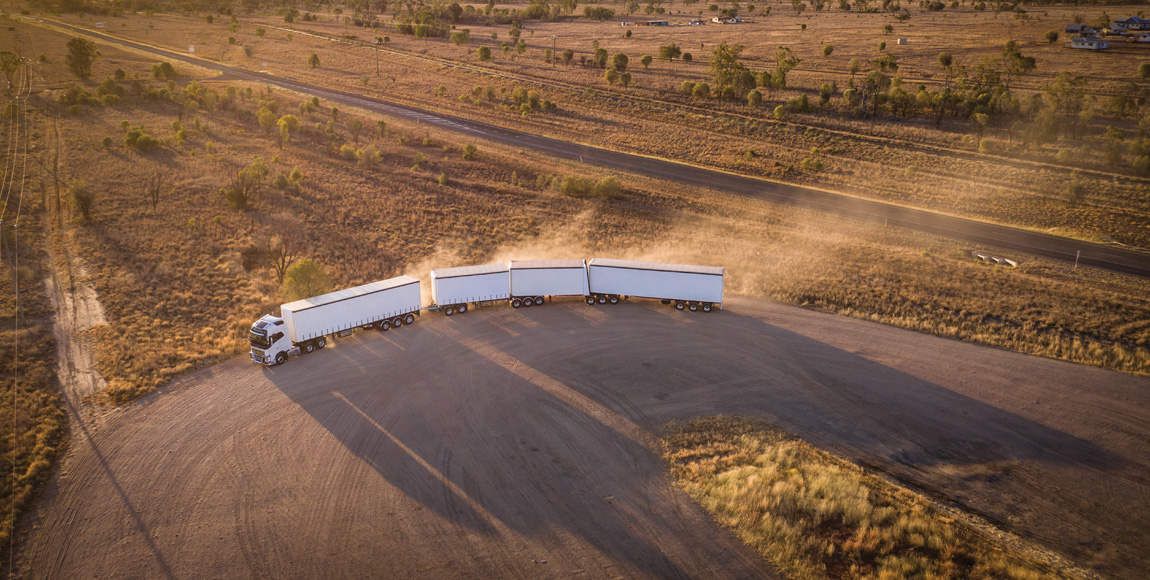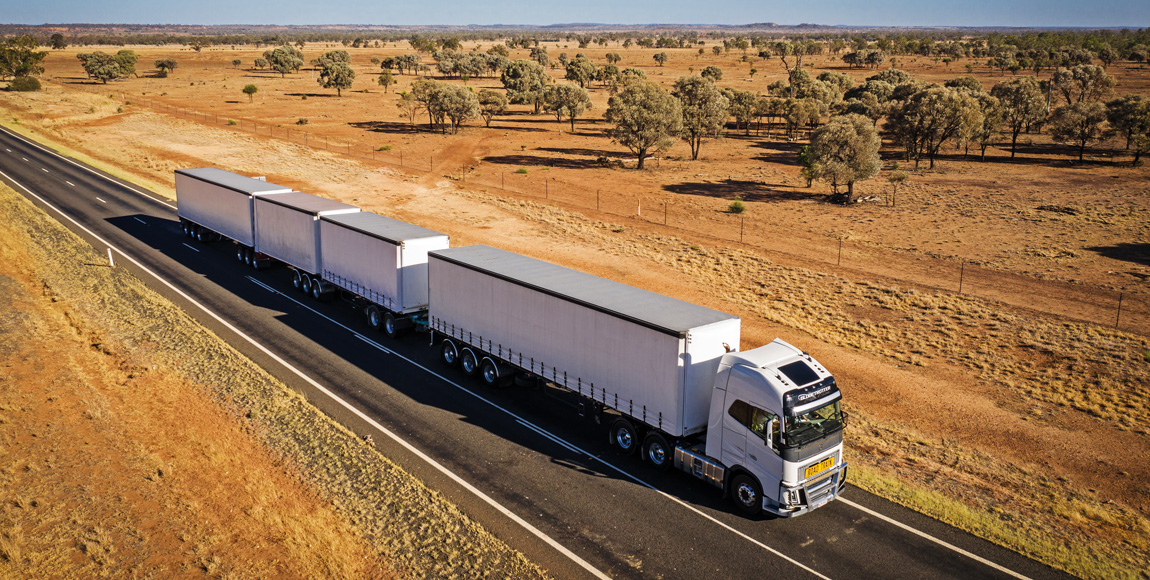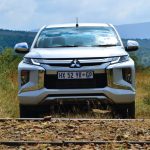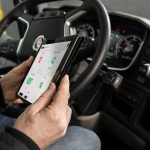52 metres, 120 tonnes, and a helluva lotta roos

WILL SHIERS, editor at the UK’s Commercial Motor, heads Down Under and discovers that the Aussies really are onto something with their crazy 52-metre, 120-tonne (or more!) road trains.
“Emus explode in a colourful cloud of feathers,” explains the driver of a 53,5-m road train when we ask him what caused the bloody mess on the front of his bonneted Mack, but of course emus aren’t the main reason why every heavy truck in Australia is fitted with a bull bar (aka roo bar).
There are considerably more kangaroos than people Down Under, and they have a nasty habit of hopping out in front of trucks. Hit a big one at 100 km/h and it will do some serious damage. Even with a bull bar in place, it’s still likely that the initial impact will destroy a headlamp assembly, and then there’s a good chance that the carcass will rip out airlines and fuel pipes as it tumbles under the truck.
Of course, no driver wants to intentionally kill an animal, but when you’re running at 50 m and 120 t, sudden swerves and emergency stops just aren’t viable options. There are, however, ways of reducing the chances of bending a bull bar, and we will find out what these are first hand while travelling into the outback in a 52-m Volvo FH16 road train.
But first of all, let us explain what we are doing here.

Platooning
The United Kingdom (UK) is about to embark on a platooning trial, which in our opinion is a waste of time and money. Daimler can’t make the technology work on North America’s big open roads, so why does the UK think it has potential on that crowded island? Instead of linking them wirelessly, does it not make more sense to join the trucks mechanically?
While numerous European countries have already introduced longer vehicles, the real experts are the Australians, who have been refining the road-train concept over the past 80-plus years. With that in mind, we boarded a flight to Brisbane, the home of Volvo Trucks Australia, to learn more.
The plan, hatched by Volvo’s driver trainers Bill Manton and Matt Wood, is to demonstrate three different truck and trailer combinations. We will gradually grow a truck as we head out of the city and into the Outback, adding trailers as legislation permits. This will allow us to experience three of the most popular combinations.
At our disposal are two locally built Volvo FH16 600s and four trailers. Volvo also offers the FH16 (a popular prime-mover for road trains) at 700 hp (522 kW), but we are assured that 600 horses (447 kW) will be more than enough for what we’ll be pulling.
The Australian-built FH16 differs to the European spec version in a number of ways, most notable being that it’s a Euro 5. As yet, Australia has no plans to adopt the latest European emissions standards. Like just about every other prime-mover sold in Australia and New Zealand, both of our trucks are 6x4s.
Unlike in North America where double-drive is frequently specified out of habit rather than necessity, the extra traction provided by the additional drive-axle is required for moving such heavy weights. The trucks’ twin fuel tanks carry 1 220 litres of diesel (split into 690 and 530 litres), while a neatly designed 140-litre AdBlue tank is slung under each chassis.
Externally, the most obvious differences are bull bars (a heavy-duty aftermarket one on the green and yellow truck and a more aerodynamic genuine Volvo part on the white one). They are an absolute must in this part of the world, and can easily prevent damage amounting to thousands of dollars in the event of an animal strike. Metal guards, which are fitted on the factory line, protect the windscreens from stones and bird strikes.
Unlike in Europe, where FH16s tend to have more bells than the Vatican and more whistles than a referee’s convention, the interiors are poverty spec. Only one has a factory-fitted fridge, and you have to operate the blinds and sunroof manually.

B-double
At the beginning of our 640-km journey both vehicles are set up as B-doubles. The “Proudly made in Australia” truck will gradually get shorter as its trailers are added to the white one in which we will be travelling.
B-doubles consist of a prime-mover with a pair of semi-trailers – “B” signifying a fifth wheel and ‘double’ because there are two of them. It is 25-m long, and is running at 60 t.
Although B-doubles have to operate on approved routes, they are widespread. Leaving Volvo’s factory, we are immediately struck by how well the trailer tracks – which is just as well as Australian B-double drivers are very proud of their driving standards, and scuffed rear tyres are to be avoided at all costs.
As we navigate through the suburbs on our way to the main freight route west, we are impressed by how little the trailers cut in.
Out on the open road we discover this configuration to be incredibly stable, too. Our observation is confirmed by Manton, who reckons the B-double is better planted than a regular tractor unit and semi-trailer as the two trailers hold each other down. He says statistically it’s safer, too, as it’s heavier and therefore slower than a regular articulated unit.
While cornering, we notice the mirrors are different to those found on European-spec vehicles, as instead of being convex, the glass is completely flat. Apparently, this makes it easier to judge distances; which is especially important when reversing a B-double.
“We prefer flat mirrors as main mirrors, but our smaller spotter mirrors are convex,” explains Manton. “We use those for seeing where trailers are on bends, and for checking on vehicles overtaking us.”
Although initially daunting, the truck turns out to be far more manoeuvrable around town than we had expected. In fact, once comfortable with the dimensions, it’s no challenge at all.
Harder to get used to is the stone guard, which we find distracting.
About 136 km outside of Brisbane is Toowoomba, Australia’s second-largest inland city. It’s 700 m above sea level, and getting there involves climbing a four-kilometre, ten-percent gradient.
As competent as Volvo’s I-Shift transmission is, at 60 t we are advised that it is better to select the manual override. We crawl up at 30 km/h in sixth gear, the rev-counter sitting at 1 200 r/min.
The B-doubles coming down the hill are likely to be in the same gear as us, slowly, but surely, descending with engine brakes on full. Manton tells us that the police regularly follow trucks down the steep gradient, issuing fines if brake lights illuminate.
The city is a transport hub, and the sheer variety of trucks on the road amazes us. This is one of the few markets where European, North American and Japanese trucks compete with each other.
In total, there are almost 20 marques to choose from, including three from the Volvo Group (Volvo, Mack and UD), all four from Daimler (Mercedes-Benz, Freightliner, Western Star and Fuso), Paccar’s DAF and Kenworth brands, Traton’s Scania and MAN, market-leader Isuzu, Iveco and even Dennis Eagle. The Chinese have had a few attempts at breaking into the market, but have failed so far.
At Toowoomba we call in on Simon National Carriers. This operator is a Volvo customer, and has a good relationship with the manufacturer. In fact, it has been testing prototype Volvos since the 1980s, and currently has a Euro-6D truck on its fleet. Volvo carries out a lot of hot-weather testing in Australia, which it can do in parallel with winter testing back in northern Sweden.
Our reason for the visit is to use its yard to attach a third trailer, which we take from the green and yellow truck. For the next 320 km it will be following us with a single semi-trailer and a dolly – both of which will later be added to our combination.
Before we add the third trailer, we have a go at reversing the B-double, which proves to be surprisingly easy after some coaching from Manton. It’s simply a case of right hand down to get the trailer to go to the right, and vice versa.

B-triple
We now have three trailers, and three fifth wheels – hence the B-triple name. These combinations can legally operate at a maximum of 83 t and 36,5 m, but ours is slightly under at 82 t and 32 m. Like the B-double, it has a maximum permitted speed of 100 km/h.
We are 22-t heavier now, but the increase in weight is barely felt from the driver’s seat. Although acceleration is slightly more lethargic, once cruising it doesn’t feel any different to the B-double, nor does it handle any differently.
Manton explains that it is far more stable than conventional three-trailer road trains, which use two dollies, giving them additional pivot points. Even on rough roads the B-triple follows us perfectly, and we are surprised to see so little lateral movement in our mirrors.
We are in an agricultural area now, and start to notice some elderly vehicles parked up in farm yards. The average age of a truck in Australia is 14 years. Typically, a prime-mover will cover 250 000 km per year, and will spend its first few years hauling combinations over vast distances. During its second life, it is likely to move between major cities on the east coast, returning to base every night. At 1,2-million kilometres it may have an engine rebuild, and then shunt trailers locally. When it reaches two-million kilometres it will probably be sold to a farmer.
Australia’s roads are in a poor state of repair and trucks suffer as a result. Tyre wear is accelerated, and suspension components take a lot of punishment. To reduce the impact of the bumps, truck drivers tend to straddle the central white line on quiet roads. Riding on the crest of the road is considerably smoother, and is kinder on the truck, driver and the freight.
In rural Queensland roads are narrow, with barely enough room for two vehicles to pass, which makes meeting other B-triples something of a challenge. The recognised technique is to ease off the accelerator, manually change down a gear, drop your nearside wheels onto the dirt, and accelerate steadily. If the approaching truck does the same, you should pass each other with little drama.
Re-joining the road sometimes causes the trailers to dance somewhat, but applying the trailer brake (or stretch brake as it’s known in Europe) soon sorts that out. At this point, with the passing truck disappearing into the distance, the drivers get on the CB radio and exchange pleasantries for a few minutes.
CBs are vital, and get plenty of use. Besides warning other truck drivers about potential hazards – like approaching wide loads, floods, bush fires or escaped livestock – striking up a conversation is a great way of fighting fatigue.
We are 400 km into the journey now, and the fields of cereal crops have been replaced by cows, searching for food in the dry scrub. Occasionally we pass a whole heard, which are being moved by cattle drovers.
Although they are supposed to erect temporary fencing to prevent the cows from wandering onto the road, we see little evidence of this. It’s surprising that they should take this risk, because if a driver hits a cow on the road, they can sue the farmer/drover for any damage to their vehicle. Our next stop is a road train coupling site on the outskirts of Roma.

BAAB quad
The sun is setting when we arrive at Roma, and we have to be quick as there is no lighting here. Hooking up the fourth and final trailer is quite a time-consuming process, too, and is far more complicated than simply attaching it to the end of our current combination. Instead, we uncouple our three existing trailers and couple the new trailer and dolly to the prime mover.
We then attempt to back it onto the three existing trailers. This proves to be more difficult than we expected; the dolly apparently having a mind of its own. It’s easy to get tied in knots when reversing a road train because of the multiple articulation points. However, there is a golden rule to follow – every time a point of articulation is added, the way the steering wheel is turned needs to change.
“Not many road-train drivers can reverse them,” says Manton, making us feel better. “The problem is the dolly, which kicks out and is difficult to control. My best advice is not to get into a situation where reversing is needed it in the first place.”
Although it would have been easier to have attached the fourth trailer at the back of the existing outfit, Manton explains that this would have been dangerous. He tells us that the closer the dolly is to the prime-mover, the more stable the road train is.
Now we will be running at 52 m and 120 t, our maximum plated weight. If we wanted to, we could legally drive
4 000 km to Perth on the east coast with this combination. In reality we intend to drive just 160 km down the road to Morven, where our journey will end.
The Roma road train coupling site is a hive of activity. We speak to the driver of a BAAB quad like ours who has driven here from Darwin, and can’t get any closer to Brisbane in this configuration. He drops his trailers and waits for a pair of B-double “dog-runners” to turn up. Between them they’ll take his four trailers east, while he’ll take their four in a westerly direction. It’s certainly a logistical challenge.
We also witness a pair of B-double livestock trucks (aka stock crates) take turns at backing onto an empty livestock road train. Between the three drivers they transfer 250 cows into the road train, which leaves in the direction of Darwin.
Before leaving, we display the road train signs on the front and rear of our truck. From now on our maximum speed is 90 km/h. All that’s left to do now is a walk-round check, which takes four times longer than usual.
As we set off, we make sure we press the minus button on the I-Shift control as we put it into gear. This lets the gearbox learn about the load, and must be done whenever a trailer is added or removed. It also ensures that it sets off in first gear.
The dolly, with its two pivot points, has made the truck slightly less stable. Small movements in the steering wheel are now amplified along the length of the truck. Manton explains that road train drivers must never hold the steering wheel too close to their bodies, and should instead push it towards the instrument cluster. This lets them hold it at arm’s length, and steer with their shoulders, instead of their arms. It has the effect of keeping movements to a minimum.
We can see the trailers wobbling in the mirror on rough patches of road, and the trailer brake is used occasionally to keep them in check. Manton tells us that if it gets really bad, and starts to snake uncontrollably, the best thing to do is accelerate hard while engaging the trailer brake. Applying the footbrake, which might be a natural instinct, could result in a jackknife.
Despite its incredible length, the truck feels only slightly less manoeuvrable than the B-triple. The dolly acts like the drive wheels of a prime mover, so from there back it has the same swept path and turning dimensions as a B-double.
It does, however, feel very heavy, which is equally as obvious going up and down hills. That said, it doesn’t feel 120-t heavy, which is testament to the torquey characteristics of the 16-litre engine. When Australia gets the Euro-6 version, with its twin turbos, it will be better again.
The I-Shift continually switches between 11th and 12th on undulating hills, so we engage manual and select 11th. This allows us to maintain a faster average speed.
Volvo’s I-See predictive cruise control would be handy, but it currently doesn’t work at this weight, having a tendency to back off the gas too early when cresting hills.
While old-school road train drivers are able to sense blow-outs on rear trailer tyres from the way that the truck behaves, less experienced drivers stand little chance of noticing them. This is of course even more of an issue when driving at night, when it isn’t possible to spot the rubber disintegrating in the mirrors.
However, a far more worrying aspect of night driving in the Outback is hitting animals. Throughout the day we have noticed countless kangaroos sitting lazily in the shade under trees, but now they’ve come to life, and the headlights pick up hundreds of them at the side of the road. Every so often one wanders out into the middle of the road on our approach.
In days of old, road trains had similar stopping distances to their rail-travelling namesakes, but things have improved considerably in recent years. According to Manton, a typical one-trailer 43-t articulated unit with a Volvo prime-mover will stop in 170 m when travelling at 90 km/h, or 195 m at 100 km/h. In comparison, a 120-t road train will take between 250 and 300 m.
However, the roos are quite big, and while the temptation is to brake or attempt to swerve around them, either evasive action would have disastrous consequences. All a road-train driver can do is wash a bit of the speed off, sound the electronic horn (not the air horn as this startles them) and turn the main beam off. Cutting the main beam is crucial, as bright lights tend to freeze them to the spot. Worse still, they cause a shadow of the kangaroo on the road behind it, which the animal believes to be another animal about to attack it, forcing it to run into the truck’s path.

Although we have a number of narrow escapes, fortunately we don’t wreck our roo bar, but other drivers have been less lucky tonight and kangaroo carcasses litter the road. The carnage is incredible, considering how few vehicles are actually using the road tonight. We pick our way through the remains, being careful not to flatten any dead ones, as the last thing we want is a rib cage puncturing a tyre. The dingos and wild cats are already starting their evening meals, dragging dead kangaroos off the road to feast on.
“Bull bars are part of the circle of life,” says Manton. “We kill the roos, which feed the coyotes, birds, dingos and wild cats.” In his 30 years of driving road trains, Manton has had most animals bounce off his bull-bar, and has even had close encounters with wild camels.
“Probably the worst thing I’ve ever hit was a swarm of bees,” he recalls. “As they hit the windscreen it was like a shotgun going off. I put the wipers on but that just made matters worse, as they were all carrying honey. I couldn’t see a thing.”
We pull up at a cafe in Morven, which has a truck park the size of a small country.
What can we learn?
So, could a BAAB quad work in other countries? Of course it couldn’t in a country like the UK, but we reckon a B-double could.
They’re manoeuvrable, safe, productive and have the ability to slash the UK’s carbon footprint. And we aren’t the only ones of this opinion.
“This is exactly the kind of innovation your country needs to be looking at,” says Manton, who has visited the UK. “The combinations can be changed around and have shorter trailers. If the first trailer is shorter and the second trailer longer, this will give a better swept path. All the regional distribution centres in the UK are close to motorways, and the motorway system is better than that of Australia.”
If the UK was to go down this route, then obviously it would require some serious investment in infrastructure and training. We reckon that £8,2 million (R150 million) earmarked for platooning should be thrown into the fund!
Published by
Focus on Transport
focusmagsa




